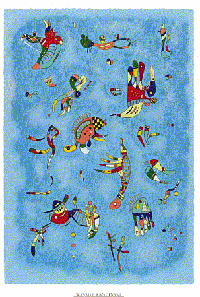Write about a piece of art that you like--a book, a poem, a painting, an architectual work--and analyze why it is good.

Assignment:
Write about a piece of art that you like--a book, a poem, a painting, an architectual work--and analyze why it is good.

Causal Analysis of Wassily Kandinsky's "Sky Blue": Why It Is Good
"Sky Blue" (1940) was painted towards the end of Kandinsky's career. It appears as blue patch of what resembles sky, bordered by a slightly lighter blue tone representing clouds. Inside the "sky", brightly colored shapes are placed seemingly at random. Some order and consistency can be perceived, however, depending on the size and color of each shape. Different sized shapes are evenly distributed throughout the patch of sky, as well as the bright, unblended colors within each shape. To me, it is obvious that the quality of this painting is "good". There are three main causes for this."Sky Blue" is almost wallpaper-like. It doesn't draw unnecessary attention to itself by jumping out at the viewer. One could easily hang a print of this painting on one's wall without worry of it ever becoming an eyesore. It can give any room a calm ambiance. There is a lot of art that comes across as "aggressive" in its form and content. "Sky Blue" merely exists as it is, without demanding esteem from the patron. It can be examined and admired, or ignored and forgotten about. The feeling held in the painting is one of relaxation; it works as an escape from the stress of reality. In a world of struggle and deadlines, a little subtlety can make a big impact. This is the goal of the painting, and Kandinsky accomplishes it well.
The symbolism used in "Sky Blue" is enough to impress even the most cynical audience. Kandinsky's painted forms resemble nothing of this earth, yet one cannot help but see people and other animals in the work. The larger shapes can be described as "not quite human" - riddled with specific appendages that merely suggest something living. These suggestions, once planted in the human mind, take on their own personalities. Because the background appears as sky, one assumes that these creatures exist, for some reason, in the air. The mind is drawn from reality into a new plane of thought to justify their existence. The human eye has an amazing ability to turn the abstract into something the brain can understand, and Kandinsky capitalizes on this fact nicely.
Once the mind assumes these creatures are alive, the viewer is instantly transported into a dream-like place. "Sky Blue", although classified under "abstract" art, accomplishes what so many surrealists tried for: to recreate the dream. Because of the ability of the mind to give the colored shapes human-like qualities, the viewer subconsciously makes assumptions. One can assume that the likeliness of one's self, floating randomly in the sky, is equal to that of the not-quite-human shapes. When one pictures one's self at the angle necessary to witness these organisms, one has transcended into the dreamscape. From there, it is easy to imagine the ability to communicate with these beings. With "Sky Blue", Kandinsky has created a painting that springs to life, yet drifts far from the realm of reality.
This is an exceptionally strong paper. The student has looked closely at the painting and made specific, insightful observations about it. Most students who choose to write about this topic speak generally about the art work but not about the specific details and how those details contribute to the overall quality. As a minor point, the writer says at the end of the first paragraph. "To me, it is obvious that the quality of this painting is 'good.' There are three main reasons why." When possible, I try to identify the three points that I will be discussing. That way the reader has a better "roadmap" of where I am going and how I am going to get there. An even more minor point is this. Periods and commas always go inside the quotation marks--regardless of context. I know--sometimes you see it differently in published books. The English have a more complex system that depends on the context. But we lazy Americans just put the periods and commas inside. Return to gallery of sample student papers